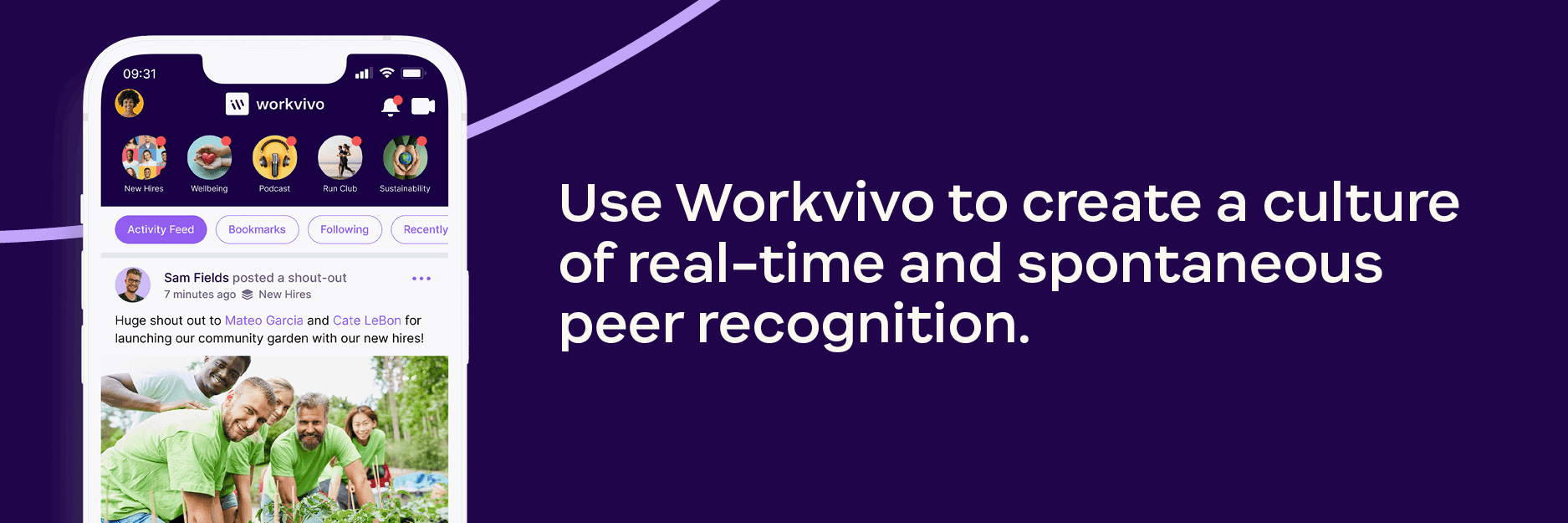Invest in EX To Positively Impact Every Part of Your Company

Lisa Ardill
Content Editor at Workvivo
11 Sept 2023

For many organizations, employee experience (EX) is just a fleeting thought. In an ideal scenario, any company trying to grow needs to invest in EX.
Employee experience is a key component of every company. It impacts the culture and morale of your employees, as well as the financial success of your company.
Simply put, the better your employee experience, the better your business will perform.
But what if you’re not ready to invest in a full-blown employee experience program?
If you’re just getting started or don’t have a lot of resources to devote to this, there are still ways to invest in EX and improve your workplace culture every day.
We’ll show you just how you can get started with improving the employee experience within your own company one step at a time.
But first, let’s get rid of those fears!
Why companies can be hesitant to invest in EX
Companies are often hesitant to invest in EX because of three core reasons:
- Employee experience is hard to measure
- It’s tough to measure the return on investment (ROI) of employee experience
- The employee experience can be expensive to build and maintain
And they couldn’t be more wrong.
That’s because:
- Measuring the employee experience can be done through surveys, interviews, and other feedback tools. If surveys allow you to get an overall understanding of how employees feel, interviews provide more detailed insights into specific areas. You can also simply track employee engagement and absenteeism. Both are strong indicators of job satisfaction and workplace well-being.
- To measure ROI, simply focus on all the data points that can be tracked. These include employee engagement, performance metrics, or employee satisfaction and loyalty. An alternative is to measure the total cost of implementing a new employee experience initiative and compare it to the benefits you’ve gained.
- Employee experience is fast and cheap to maintain as technology has made it easier than ever to manage information, communicate with employees, and receive feedback. You can rely on digital platforms to automate tasks and provide employees with real-time access to their data, allowing them to stay informed and current on their work progress.
It’s worth noting that every company might experience its own challenges.
Simon Bacher, Co-Founder of Simya Solutions and creator of the Ling App, says they were too focused on the technical aspect of our product during the first few months after launching Ling:
“Everybody was expected to be at their best. Our web team was busy improving intuitiveness, speed, and user experience while the rest were implementing aggressive sales and marketing campaigns. We only realized the importance of employee experience once we noticed a decline in our sales for three consecutive months.
Since then, we have invested in enhancing employee experience by implementing more flexible work schedules, giving awards and incentives, and other employee engagement initiatives. Because of these efforts, we’ve noticed a significant increase in our app download rate (200%) and business revenue.”
Felicity Brown, Chief People Officer at Flintfox, was also unsure employee experience investments would be worth it when looking at the immediate goals:
“As a growing SaaS, we were hesitant to invest in improving the employee experience as we didn’t believe that it would have sufficient short-term impact to help our company grow. However, after making several small investments, we realized how important it is to invest in this.
Investing in the employee experience helped us reduce turnover rates, improve morale and performance, and it also helped us improve our overall revenue. Today, I believe backing the employee experience is crucial to SaaS growth, especially because it adds to team longevity, morale, and performance.”
What investing in the employee experience looks like
Investing in the employee experience can provide a huge range of benefits for employers and employees alike. By creating a positive environment, employers can attract and retain the best talent, increase employee engagement and motivation, and improve overall workplace productivity.
Investing in the employee experience can also lead to improved customer experience. Employees who are more engaged and motivated so they’re better able to serve customers. Overall, this creates a more positive company culture and brand recognition, helping you create a better reputation for your company.
Now let’s see just what this investment looks like at every step of the employee experience.
Attracting top talent
Employees who have a positive experience in the workplace are more likely to be productive and engaged, which creates an attractive environment for potential job seekers.
Providing employees with quality benefits, flexible hours, training and development opportunities, and a positive work culture can help to draw in potential candidates — who are looking for a workplace that values their contribution and offers them the opportunity to grow and develop.
On this note, Max Wesman, COO at GoodHire, remarks:
“The employee experience is felt even before people become employees. When your company’s culture is strong, and your employees feel secure, respected, and happy, that’s felt by candidates in the recruitment process. That’s even noticed by customers when a company like Starbucks does employee experience well.
Recruiting is getting hard as businesses continue to vie for top talent, and employee experience can act as a magnet to attract all the best talent your way. We’ve seen first-hand that when you build a great experience, more great people will naturally want to work for you!”
Additionally, offering competitive wages and taking the time to recognize and reward employees for their hard work can go a long way toward creating a positive working environment that will draw in the best talent.
It’s important to note that the employee experience’s impact on hiring is more than just the culture you create.
Having a thorough recruitment process is essential if you’re looking to recruit and retain high-quality talent. Not only should the process be straightforward for candidates, but it also needs to provide the insights they need into what your organization offers and why they should join.
Use your Careers page and job descriptions (alongside your initial candidate communication) to highlight the benefits of your organization that make it stand out from the competition. Consider relying on tools such as online application portals and automated interview scheduling to create a more efficient and user-friendly experience.
How to get results with Workvivo: Use Workvivo to create a culture of real-time and spontaneous peer recognition, building a feel-good factor for everyone in your company. Showcase both team and individual results through public shout-outs and kudos. You can also use peer comments to bolster recognition and nourish team connections.
Cultivating employee creativity
Marnix Broer, Co-Founder and CEO of Studocu, notes that if you’re not investing in the employee experience, you’re missing out on building the best ideas and strategies:
“Creativity can’t be cultivated in an environment where employees feel stifled, bored, or disrespected, so the quality of creative ideas is inextricably linked to employee experience. That’s why we lean heavily into two things: flexibility and fun.”
Marnix’s team doesn’t believe in forcing employees to come into the office. Instead, they craft the entire employee experience around a work setting that lets them grow:
“We’ve built an interactive environment with plenty of perks that give the best experience when there. We also invest in company-wide annual retreats abroad. When you connect for fun, you leave space and safety for your team to share their most creative ideas with you!”
Some other things you can try to support creativity include:
- Encouraging employees to work together, brainstorm ideas, and provide feedback to one another
- Creating a safe environment where they can express their ideas and opinions
- Acknowledging and rewarding employees for their contribution
- Celebrating failure and encouraging experimentation
- Providing resources such as training programs or books to help employees learn new skills
- Hosting creative activities such as art classes, music workshops, and other activities — virtual or not
- Offering flexible work schedules to allow employees the freedom to manage their time in ways that work best for them
How to get results with Workvivo: Use public announcements and comments from coworkers to showcase appreciation and create strong team ties. Workvivo lets employees incorporate the goals and values of the company in their posts, and stay focused on the company’s objectives.
Órla Stack, the Digital Marketing Institute’s HR Director, uses a ‘Cheers From Your Peers’ award to promote team members. After every awards event, campaign leaders post a news article to Workvivo that includes all the nominations that were received for that month. This allows those who weren’t winners to still read encouraging comments from colleagues.
Keeping your employees for the long run
Using the employee experience to improve employee retention can help you create a positive working environment for employees. It can also make employees feel valued and appreciated, which leads to higher job satisfaction and a greater commitment to staying with the organization.
When employees feel that their employer is invested in their success and happiness, they’re more likely to stay with the company for a long time. But in a world where only 13% of employees are fully satisfied with their experience, you need to prioritize retention together with an improved employee experience to achieve these results.
For Kimberly Otis, Senior HR Manager at Checkr retention is top of mind right now — and for good reason:
“If your employees aren’t having a good time, the skilled labor shortage leaves them with plenty of alternative roles to choose from. And that same shortage will make it very hard to replace them. While you can’t prevent every employee from leaving, improving employee experience helps you create some very compelling reasons to stay!”
To do this, the Checkr team has invested heavily in the employee experience by building a strong ERG (Employee Resource Groups) program:
“We’re also using inclusive hiring practices to promote diversity and fairness. When you build your business foundation on these strong values that protect your team, their trust in you always leads to higher employee experience.”
How to get results with Workvivo: Let your employees build up and maintain Spaces. These can act as dedicated groups for employees who shared common interests or activities. The goal? To build real friendships. People simply want to have more friends at work. According to Gallup’s research, having a best friend at work is associated with extra benefits for businesses, such as increased profitability, better safety, and higher employee retention rates.

Maintaining peak communication levels
Chino Nnadi, Global Talent Strategist and Founder at Consult x Chino Inc., shares with us her best tips for creating an impactful employee experience that relies on communication as a means of support and advancement:
“Only way to do that is to actually speak to your employees. You can use surveys, consultants, one-on-one meetings, or performance reviews for this. From there, you’ll need to rely on either a committee that focuses on the employee experience or an individual to gather the insights and create custom-tailored programs.”
During our talk with Chino, she also stressed the importance of incorporating diversity, equity, inclusion, and accessibility (DEIA) practices into your internal communications strategy:
“For some, classic activities like a movie night, happy hour meeting, or virtual escape room might work. But you should also try out an open-door policy to allow people to talk about their needs and challenges from a DEIA lens. This will help you make sure that everybody feels like they have an opp to share their voice and contribute to the development of your company as a business or workplace alike.”
Tip: Adapt your internal communication practices based on the feedback you get from employee satisfaction assessments. Marek Nebesář, Operations Director at Behavio Labs, draws from these insights and formulates enhancements like refining the office environment, streamlining processes, or reducing bureaucracy:
“One of the aspects we’re constantly improving based on these insights is internal communication and the extent to which employees are informed. Insights we gather guide our decisions and investments in innovative methods of internal comms to ensure that what’s important gets to everyone on time.”
How to get results with Workvivo: Use our social intranet to increase employee engagement and create an environment of inclusion for all backgrounds, gender identities, nationalities, and more. Workvivo offers a secure platform for employees to access DEIA programs (such as Employee Resource Groups), try out mentorship programs, or open up conversations about psychological safety and well-being.

When you invest in EX, you improve all areas of business
Employees should be empowered to voice their ideas and be kept updated with any changes in the organization.
Focusing on the employee experience helps to foster an environment of open communication and engagement between managers and workers, leading to better working relationships, improved productivity, and higher employee retention rates.
So let us look into how effective employee experience investments can benefit different areas of your business.
Reducing absenteeism
Investing in the employee experience reduces absenteeism because you’d be creating a positive and motivating work environment. You can do this by offering employee benefits such as flexible work arrangements, opportunities to learn and grow, and recognition and rewards for good performance.
You should also focus on creating a culture of wellness by providing access to quality health benefits, regular exercise, and health check-ups, as well as mental health support whenever employees need it. By creating this type of environment that values and supports employees, employees will feel more engaged and motivated to come to work.
Jack Underwood, CEO & Co-Founder at Circuit, remarks you should focus on keeping your team engaged to make sure they’ll show up more often:
“Absenteeism can kill productivity. With hundreds of thousands of employees missing work daily because of stress, it’s become a real issue. If you have a remote or hybrid team, absenteeism is even harder to spot since you’re not working side-by-side. When employees have a healthy work experience, they want to engage with their work more.”
Improved customer experience
Happy and engaged employees are better equipped to provide a high-quality customer experience. They have a better understanding of customer needs and can provide more informed and helpful advice. Plus, they’re more likely to go the extra mile to exceed customer expectations. In turn, this leads to increased customer loyalty and satisfaction.
In our talk with Jack Underwood, he also emphasized the results you can see on the customer satisfaction side.
“Engaged employees create better customer experiences. Your employee experience inevitably affects your customer experience because your employees are the ones strategizing, designing, communicating, and delivering to them!
If you work to elevate your employees’ experiences higher, they feel appreciated. It’s much easier to extend that appreciation to the customer, whose purchases help their employers fund their own experiences.”
Higher staff morale
Think of it this way: By improving the overall employee experience you’ll be influencing every single department in your organization.
You can do so by providing employees with the resources and support they need to feel valued and fulfilled. This could include additional training, better workspace amenities, access to development opportunities, or even small things like providing snacks and drinks.
Investing in the employee experience can also help build trust and relationships between staff members which naturally leads to increased motivation and engagement.
Kyle Kuczynski, CMO and Co-Founder of MessageDesk, leads a small team where employees have to experiment with different responsibilities and processes. While the size of the team makes it easier to stay connected, a culture of experimentation also means Kyle has to support failure celebration and teach his team to learn from it:
“A positive work environment. That’s what you want to build. We’re always trying out new things and they’re not always successful. So we’re supportive of trying out new things and learning from both the good achievements as well as failures. This single ‘trick’ has helped us keep morale high and provide employees with a sense of belonging and purpose.”
Next steps
Don’t forget employee experience is both a short- and long-term investment.
Kyle Elliot, Tech Career Coach, says that investing in employee experience can pay off both immediately and down the road:
“In the short term, you get happy, productive workers that can provide you with their best effort. In the long term, you retain and develop employees that stay and grow with your company.”
Ready to invest in EX?
To start getting results from week one, book a free Workvivo demo! We’ll show you just how you can create a sense of belonging and build a company culture others can only dream of.

